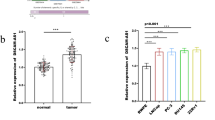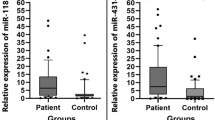Abstract
Increasing evidence shows that dysregulation of microRNAs is correlated with tumor development. This study was performed to determine the expression of miR-141 and investigate its clinical significance in pancreatic ductal adenocarcinoma (PDAC). Taqman quantitative RT-PCR was used to detect miR-141 expressions in 94 PDAC tissues and 16 nontumorous pancreatic tissues. Correlations between miR-141 expression and clinicopathologic features and prognosis of patients were statistically analyzed. The effects of miR-141 expression on growth and apoptosis of PDAC cell line (PANC-1) were determined by MTT, colony formation, and flow cytometry assays. Potential target genes were identified by luciferase reporter and Western blot assays. The expression level of miR-141 in PDAC tissues was significantly lower than that in corresponding nontumorous tissues. Downregulation of miR-141 correlated with poorer pT and pN status, advanced clinical stage, and lymphatic invasion. Also, low miR-141 expression in PDAC tissues was significantly correlated with shorter overall survival, and multivariate analysis showed that miR-141 was an independent prognostic factor for PDAC patients. Further, functional researches suggested that miR-141 inhibits growth and colony formation, and enhances caspase-3-dependent apoptosis in PANC-1 cells by targeting Yes-associated protein-1 (YAP1). Therefore, miR-141 is an independent prognostic factor for PDAC patients, and functions as a tumor suppressor gene by targeting YAP1.






Similar content being viewed by others
References
Jemal A, Siegel R, Xu J et al (2010) Cancer statistics, 2010. CA Cancer J Clin 60:277–300
Giovinazzo F, Turri G, Zanini S et al (2012) Clinical implications of biological markers in pancreatic ductal adenocarcinoma. Surg Oncol 21:e171–e182
Krautz C, Rückert F, Saeger HD et al (2011) An update on molecular research of pancreatic adenocarcinoma. Anticancer Agents Med Chem 11:411–417
Pasquinelli AE, Ruvkun G (2002) Control of developmental timing by micrornas and their targets. Annu Rev Cell Dev Biol 18:495–513
Ke XS, Liu CM, Liu DP et al (2003) MicroRNAs: key participants in gene regulatory networks. Curr Opin Chem Biol 7:516–523
Takaya T, Nishi H, Horie T et al (2012) Roles of microRNAs and myocardial cell differentiation. Prog Mol Biol Transl Sci 111:139–152
Sharma A, Wu JC (2013) MicroRNA expression profiling of human-induced pluripotent and embryonic stem cells. Methods Mol Biol 936:247–256
Jovanovic M, Hengartner MO (2006) MiRNAs and apoptosis: RNAs to die for. Oncogene 25:6176–6187
Dalmay T, Edwards DR (2006) MicroRNAs and the hallmarks of cancer. Oncogene 25:6170–6175
Shen J, Stass SA, Jiang F (2013) MicroRNAs as potential biomarkers in human solid tumors. Cancer Lett 329:125–136
Zhang L, Jamaluddin MS, Weakley SM et al (2011) Roles and mechanisms of microRNAs in pancreatic cancer. World J Surg 35:1725–1731
Wang J, Sen S (2011) MicroRNA functional network in pancreatic cancer: from biology to biomarkers of disease. J Biosci 36:481–491
Yu XY, Zhang Z, Liu J et al (2013) MicroRNA-141 is downregulated in human renal cell carcinoma and regulates cell survival by targeting CDC25B. Onco Targets Ther 6:349–354
Hu M, Xia M, Chen X et al (2010) MicroRNA-141 regulates Smad interacting protein 1 (SIP1) and inhibits migration and invasion of colorectal cancer cells. Dig Dis Sci 55:2365–2372
Du Y, Xu Y, Ding L et al (2009) Down-regulation of miR-141 in gastric cancer and its involvement in cell growth. J Gastroenterol 44:556–561
Zhang Z, Li Z, Gao C et al (2008) MiR-21 plays a pivotal role in gastric cancer pathogenesis and progression. Lab Invest 88:1358–1366
Wang R, Huang J, Feng B et al (2012) Identification of ING4 (inhibitor of growth 4) as a modulator of docetaxel sensitivity in human lung adenocarcinoma. Mol Med 18:874–886
Imanaka Y, Tsuchiya S, Sato F et al (2011) MicroRNA-141 confers resistance to cisplatin-induced apoptosis by targeting YAP1 in human esophageal squamous cell carcinoma. J Hum Genet 56:270–276
Nolan T, Cogoni C (2004) The long hand of the small RNAs reaches into several levels of gene regulation. Biochem Cell Biol 82:472–481
Fernández-Hernando C, Ramírez CM, Goedeke L et al (2013) MicroRNAs in metabolic disease. Arterioscler Thromb Vasc Biol 33:178–185
Crippa S, Cassano M, Sampaolesi M (2012) Role of miRNAs in muscle stem cell biology: proliferation, differentiation and death. Curr Pharm Des 18:1718–1729
Zhang B, Pan X, Cobb GP et al (2007) MicroRNAs as oncogenes and tumor suppressors. Dev Biol 302:1–12
Lee YS, Dutta A (2006) MicroRNAs: small but potent oncogenes or tumor suppressors. Curr Opin Investig Drugs 7:560–564
Cheng H, Zhang L, Cogdell DE et al (2011) Circulating plasma MiR-141 is a novel biomarker for metastatic colon cancer and predicts poor prognosis. PLoS ONE 6:e17745
Leskelä S, Leandro-García LJ, Mendiola M et al (2010) The miR-200 family controls beta-tubulin III expression and is associated with paclitaxel-based treatment response and progression-free survival in ovarian cancer patients. Endocr Relat Cancer 18:85–95
Gonzales JC, Fink LM, Goodman OB Jr et al (2011) Comparison of circulating MicroRNA 141 to circulating tumor cells, lactate dehydrogenase, and prostate-specific antigen for determining treatment response in patients with metastatic prostate cancer. Clin Genitourin Cancer 9:39–45
Jia Y, Yang Y, Zhan Q et al (2012) Inhibition of SOX17 by microRNA 141 and methylation activates the WNT signaling pathway in esophageal cancer. J Mol Diagn 14:577–585
Berkers J, Govaere O, Wolter P et al (2013) A possible role for microRNA-141 down-regulation in sunitinib resistant metastatic clear cell renal cell carcinoma through induction of epithelial-to-mesenchymal transition and hypoxia resistance. J Urol 189:1930–1938
Sudol M, Shields DC, Farooq A (2012) Structures of YAP protein domains reveal promising targets for development of new cancer drugs. Semin Cell Dev Biol 23:827–833
Tschaharganeh DF, Chen X, Latzko P et al (2013) Yes-associated protein up-regulates Jagged-1 and activates the Notch pathway in human hepatocellular carcinoma. Gastroenterology 144(1530–42):e12
Yuan M, Tomlinson V, Lara R et al (2008) Yes-associated protein (YAP) functions as a tumor suppressor in breast. Cell Death Differ 15:1752–1759
Li SY, Hu JA, Wang HM (2013) Expression of Yes-associated protein 1 gene and protein in oral squamous cell carcinoma. Chin Med J (Engl) 126:655–658
Yeo MK, Kim SH, Kim JM et al (2012) Correlation of expression of phosphorylated and non-phosphorylated Yes-associated protein with clinicopathological parameters in esophageal squamous cell carcinoma in a Korean population. Anticancer Res 32:3835–3840
Diep CH, Zucker KM, Hostetter G et al (2012) Down-regulation of Yes associated protein 1 expression reduces cell proliferation and clonogenicity of pancreatic cancer cells. PLoS ONE 7:e32783
Acknowledgments
The authors wish to thank Prof. Rui Wang and Dr. Ming Sun for their technical support and sincere help.
Author information
Authors and Affiliations
Corresponding author
Additional information
Zi-Man Zhu, Yue-Fang Xu and Qin-Jun Su should be regarded as joint first authors for their equal contributions.
Rights and permissions
About this article
Cite this article
Zhu, ZM., Xu, YF., Su, QJ. et al. Prognostic significance of microRNA-141 expression and its tumor suppressor function in human pancreatic ductal adenocarcinoma. Mol Cell Biochem 388, 39–49 (2014). https://doi.org/10.1007/s11010-013-1897-y
Received:
Accepted:
Published:
Issue Date:
DOI: https://doi.org/10.1007/s11010-013-1897-y




